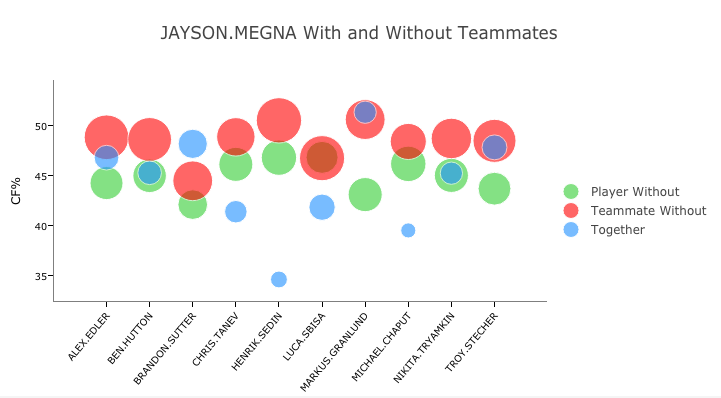Canucks Army Year in Review: Jayson Megna

By Taylor Perry
6 years agoRightly or wrongly, Jayson Megna came to symbolize everything wrong with the Willie Desjardins-coached Canucks. Whether it was deployment issues or a curiously high number of power play minutes, Megna became something of a lightning rod for the ire of Canucks Nation.
This is all a little unfair to Megna. After all, he signed a one-year, one-way $600,000 last July in the hopes of providing some depth to a Canuck organization determined to make the playoffs. But when injuries began to strike players like Derek Dorsett, Jannik Hansen, and Anton Rodin, Desjardins was forced to move Megna up the depth chart. Once a likely press box warrior or Utica afterthought, Megna instead became a fairly prominent player on a terrible team. Not exactly a recipe that would endear him to Canuck fans in his first season with the club.
Part of the criticism was directed at Desjardins’ usage of Megna. The Canucks’ former head coach routinely slotted Megna on the Sedin line, which proved a drag on the twins’ performance. From Canucks Army’s Jackson McDonald in late March:
The Sedins and Jayson Megna had just a 37% share of shot attempts, a 40% share of scoring chances, and carried an expected goals-for percentage of 37.6% while on the ice together … [and] in 83:08 minutes of TOI with Jayson Megna, the Sedins managed just one goal between the two of them, and no assists. Megna had 0s across the board.
Thanks to our friends at Corsica Hockey, we can see that Megna’s presence hampered all of his regular linemates at even strength, with the notable exception of Brandon Sutter. Henrik Sedin, in particular, suffered severely with Megna on his line. As Jackson mentioned in his previous piece, Henrik averaged a below 40% share of shot attempts with Megna – very un-Sedin-like numbers for the Canuck legend.

In addition to that arrangement, Desjardins often placed Megna on the power play, despite putting up exactly one assist in that role all season. At 27, fans were further upset by the appearance that Megna was seemingly getting preferential treatment over younger, skilled players like Nikolay Goldobin (21). All told, Megna finished the season with four goals and four assists while averaging 12:26 of ice time per night. His individual possession numbers were equally troubling.

If the numbers look bad on the surface, it gets worse when you dig a little deeper. Of all players to play at least 20 games with the Canucks this season, no one had a lower CF% at even strength than Megna at 45.0% (for context, Brandon Sutter was the second-worst forward at 45.2%). Essentially every linemate of Megna’s performed better with him on the bench than skating alongside him on the ice.
But all coaches have their blind spots. We have often mentioned Alain Vigneault’s love of Tanner Glass in this fashion. Desjardins recognized in Megna a player he could trust, even if all the evidence pointed in a different direction. Management, for its part, must have seen something the fans did not, too. In April, Jim Benning rewarded Megna with another one-year, one-way deal – this time worth $675,000.
With a new coach in Travis Green, it stands to reason that all players in the organization will receive a fresh start. At this stage in his career, it is unlikely that Megna will develop into anything more than the player he is today. However, if Green utilizes him in a role more suited to his skill set, then perhaps some of the animosity towards Megna’s game should subside. After all, Megna was ultimately deployed in a role for which he was poorly suited and/or capable of handling. Few players would baulk at the coach’s suggestion to play alongside the Sedin twins – and Megna was no different. This upcoming season, it is imperative that the coaching staff recognize Megna for the player that he is and utilize him accordingly. Otherwise, we may risk repeating ourselves in this space again this time next year.
Recent articles from Taylor Perry





